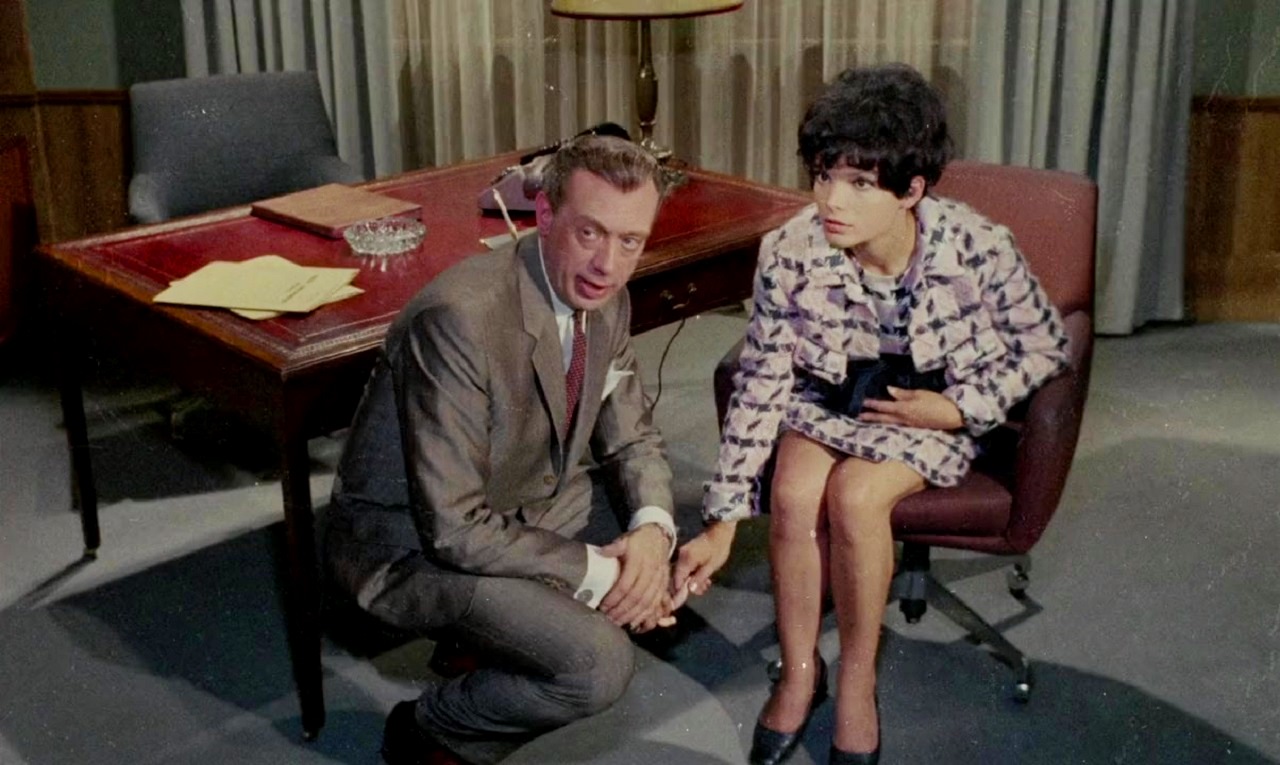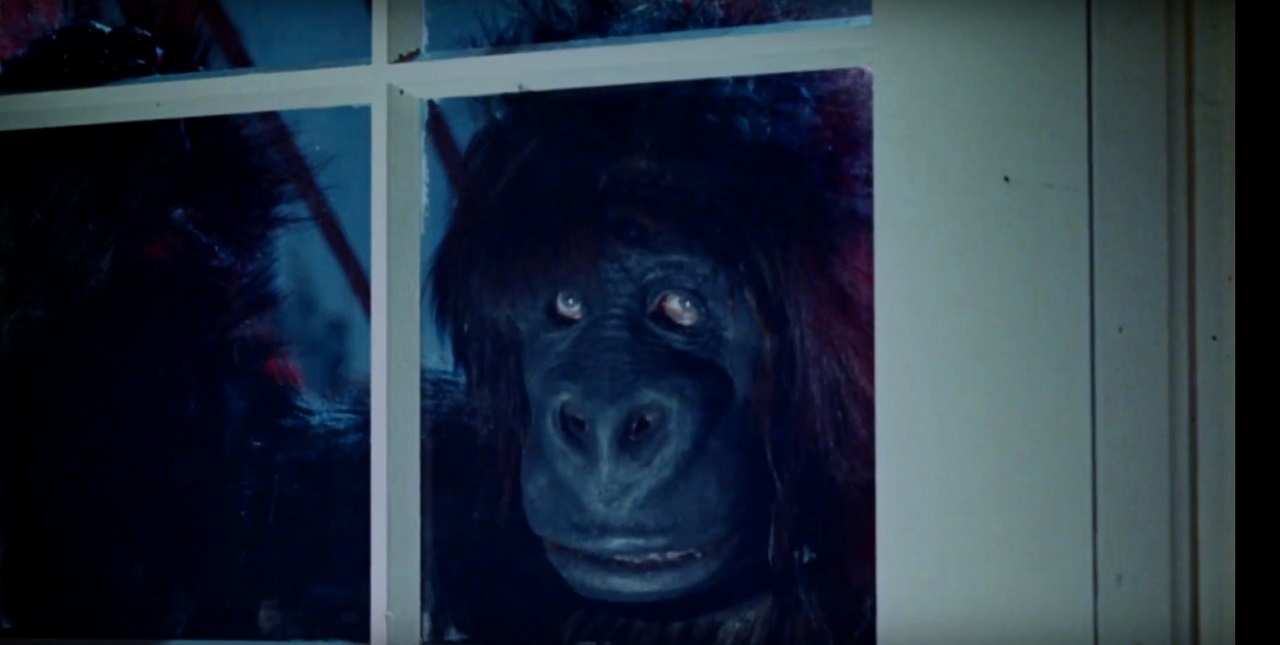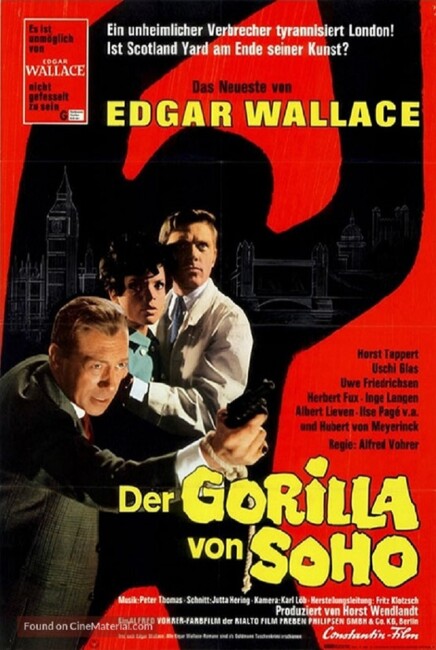aka The Gorilla Gang
(Der Gorilla von Soho)
West Germany. 1968.
Crew
Director – Alfred Vohrer, Screenplay – Freddy Gregor, Based on the Novel The Dark Eyes of London by Edgar Wallace, Producer – Horst Wendlandt, Photography – Karl Löb, Music – Peter Thomas, Production Design – Walter Kutz & Wilhelm Vorwerg. Production Company – Rialto Film Preben Philipsen GmbH & Co KG.
Cast
Horst Tappert (Inspector Perkins), Uschi Glas (Susan McPherson), Uwe Friedrichsen (Sergeant Jim Pepper), Hubert von Meyerinck (Sir Arthur), Herbert Fux (Mr Sugar), Albert Lieven (Henry Parker), Inge Langen (Mother Superior), Beate Hausenau (Cora Watson), Hilde Sessak (Sister Elizabeth), Ralf Schermuly (Edgar Bird), Ilse Pagé (Mabel Finley), Maria Litto (Gloria), Catana Cayetano (Dorothy Smith)
Plot
Inspector Perkins of Scotland Yard investigates a case where the body of a millionaire businessman has been dragged from the Thames, one of several similar murders. Several witnesses saw a killer in a gorilla suit and Perkins believes The Gorilla Gang may be behind this. Found in the pocket of the body is a doll that has smudged words in an African language written on it. Susan McPherson is brought in to assist with the case, having lived in Africa. The trail leads them through London’s gentlemen’s clubs to the Love and Peace for People charity to St Mary’s Home for orphan girls.
British thriller writer Edgar Wallace (1874-1932) was once considered the fastest and most prolific writer in the world. It was at one point estimated that a quarter of all fiction read in the English language was one of Edgar Wallace’s works. Before his death, Wallace had churned out some 175 novels, 24 plays and 957 short stories. The greater portion of Wallace’s novels were detective thrillers where he was sometimes known to complete books in the space of 72 hours.
Wallace has been very popular on film – the IMDB lists some 189 Edgar Wallace film adaptations. Some 80 odd of these were produced between the silent era through to the 1940s. Wallace himself even directed two adaptations – Red Aces (1929) and The Squeaker (1930). Wallace also received credit as co-writer on the original King Kong (1933), although died before the film went into production. Wallace’s works were adapted into a series of 43 British B programmers made between 1960 and 1965, which were later packaged for television as The Edgar Wallace Mysteries and are generally held to be the most faithful of all Wallace screen adaptations.
For some reason, Edgar Wallace has an extraordinary popularity in Germany. During the 1960s, there was a host of Wallace film adaptations made in West Germany, beginning with Harald Reinl’s The Face of the Frog (1959) and 32 other films, which were then followed by seven adaptations of novels by Wallace’s son Bryan Edgar Wallace. Most of these German films have little to do with the Wallace texts they are based on and instead spin out a series of luridly Grand Guignol murder mysteries. These became a genre unto themselves known as krimi films.

The Gorilla of Soho/The Gorilla Gang is one of these krimi films. This is not an Edgar Wallace title and the film itself is adapted from Wallace’s novel The Dark Eyes of London (1924), which had been filmed twice before as The Dark Eyes of London/The Human Monster (1939) starring Bela Lugosi and the German-made Dead Eyes of London (1961), also from this film’s director Alfred Vohrer. Wallace’s book concerns the owner of a institute for the blind acting as a front for an insurance agent to conduct a scam to kill people for their inheritance. The charity scam is retained here, although the blind institute now becomes a girl’s orphanage. Added entirely to the story are the killer in the gorilla suit, the dolls with messages left on them (it was Braille messages in Wallace’s original) and the venture through the London gentlemen’s clubs.
The krimi films have a certain cultish fascination. The plots were stolid Police Procedurals with the efforts to mimic a London setting sometimes being odd. However, they have an undeniable colourful weirdness. In the opening scenes here, we have a killer wearing a gorilla suit emerge from a launch in a canal to attack a victim. The subsequent Scotland Yard investigation reveals a doll hidden on the body with smudged writing in an African language.
The investigation takes Horst Tappert’s inspector to visit a gentlemen’s club, which contains some nudity for the time (where it appears that most patrons don’t regard the women as hookers but rather quaintly go there to take photos of them – I am not sure if this was ever a real thing due to the censorship restrictions on pornography at the time). Elsewhere we pay visits to a charitable organisation and a girls’ orphanage where clues seem to centre around a mute orphan from an African country who goes missing. There are further attacks by the gorilla that dumps bodies in vats in the orphanage basement and makes its getaway in an ambulance. Later the gorilla is revealed to be a hideously disfigured criminal who hides his face behind the gorilla suit.
The problem with the film is that these abovementioned elements provide a good deal of offbeat colour that make the show undeniably interesting, but also come in a plot where it is frequently confusing trying to follow the connection made between one aspect and the next. It never coheres as any kind of thriller plot, although an eventual explanation is pulled out of thin air at the end that does tie things together for the most part. Certainly, the film has an undeniable sense of humour going for it – like the character of the police head Sir Alfred (Hubert von Meyerinck) and the girl from the gentlemen’s club he sneaks into his office.

The film also has the oddity of a lawyer named Jekyll. With such a name, you assume the film is going to become a Jekyll and Hyde story but it doesn’t – you can only guess that Jekyll was thrown in by a German writer unfamiliar with England because it was assumed to be a common British surname. The other frustrating oddity is that the film is titled The Gorilla Gang in some English-language releases – the characters refer to them as a bande, which is German for gang, but you keep mentally translating it as the Gorilla Band. For all that, The Gorilla Gang/Bande never feature in the film. All that we ever get is Horst Tappert’s Inspector saying that the gorilla killer reminds him of the Gorilla Gang case he once investigated and that is the sole relevance.
Alfred Vohrer (1914-86) was a regular director of krimi films and made fourteen Edgar Wallace adaptations with Dead Eyes of London (1961), The Door with Seven Locks (1962), The Inn on the River (1962), The Indian Scarf (1963), The Squeaker (1963), The Mysterious Magician (1964), Again the Ringer (1965), Circus of Fear (1966), The Hunchback of Soho (1966), Creature with the Blue Hand (1967), The College Girl Murders (1967), The Hound of Blackwood Castle (1968), The Zombie Walks (1968), The Man with the Glass Eye (1969) and Seven Blood Stained Orchids (1972).
Other Edgar Wallace adaptations that fall into genre material include The Terror (1928), Before Dawn (1933), Mystery Liner (1934), The Terror (1938), Chamber of Horrors (1940), The Dark Eyes of London/The Human Monster (1939), The Avenger (1960), The Gang of Terror/Hand of the Gallows (1960), Dead Eyes of London (1961), The Door with the Seven Locks (1962), The Inn on the River Thames (1962), The Black Abbott (1963), The Curse of the Yellow Snake (1963), The Indian Scarf (1963), The Squeaker (1963), Room 13 (1964), The Sinister Monk (1965), The Phantom of Soho (1966), The College Girl Murders (1967), Creature with the Blue Hand (1967), The Hand of Power (1968), The Horror of Blackwood Castle (1968), The Devil Came from Akasava (1971), Seven Blood-Stained Orchids (1972) and What Have They Done to Solange? (1972). Wallace also worked as a screenwriter, turning out an adaptation of The Hound of the Baskervilles (1932), with his most famous being the original story for King Kong (1933).
Trailer here (no English subtitles)

